Search the Special Collections and Archives Portal
Search Results
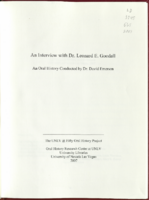
Transcript of interview with Dr. Leonard Goodall by Dr. David Emerson, March 28, 2006
Date
2006-03-28
Archival Collection
Description
Dr Leonard Goodall, former president of UNLV, comes from a unique educational background. He was born in Warrensburg, Missouri, a small town of only 6,000 souls, and received 12 years of education in the same building. After high school, he attended Central Missouri State College, which was only about 2 miles from his home. Dr. Goodall earned his master's degree at the University of Missouri, and attended the University of Illinois for his doctorate in political science. He went right into academic life, accepting a job at Arizona State in Tempe on the basis of a phone call. For five years he taught in the department of Political Science and conducted research at the institute. He subsequently moved to the University of Illinois Chicago as instructor and then chancellor (four years), and from there to the University of Michigan Dearborn as chancellor (eight years). In 1979, Leonard accepted a position as president of UNLV. He oversaw the development of the College of Engineering, helped create the UNLV Foundation, and made a number of appointments, such as athletic director, any number of deanships, and academic vice president of student affairs. After his presidency, Dr. Goodall returned to his professorship in public administration and served on many campus committees. He phased his retirement over several years, and was completely out in 2002. Today, Leonard continues to serve on graduate committees for UNLV, and works on the search committee to find a new president.
Text
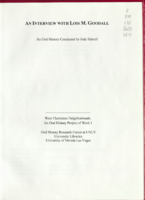
Transcript of Lois M. Goodall by Judy Harrell, November 12, 2013
Date
2013-11-12
Archival Collection
Description
Lois Goodall, wife of the fourth president of UNLV, Dr. Pat Goodall, speaks with pride when recalling her early life, marriage, and involvement with the University of Nevada, Las Vegas. She grew up in Odessa, Missouri, with a father who was a farmer and a teacher mother, went to college to become a teacher, and her freshman year met a young sophomore gentleman by the name of Pat Goodall. They married and while Pat attended graduate school at the University of Missouri, she taught fifth grade. After Pat earned his Ph.D. they moved to Arizona State University, where he taught political science, and then to the University of Illinois, the University of Michigan, and finally to UNLV. Lois, as the president's wife, enjoyed hosting various celebrities and faculty, was responsible for raising three children, and, miraculously, found time to earn her Master of Education degree in reading education and curriculum. She received her Master's hood from her husband, the president of the university, at her graduation. Expressing enthusiasm, Lois Goodall shows great delight in UNLV's growth and development. The university's Hotel Administration is second to none, and subsequent programs such as the addition of a law school imply maturity and expansion. She also admires the generosity and far sightedness of such individuals as Jerry Mack and Parry Thomas who not only funded the Thomas & Mack Center but purchased surrounding land so that the university could expand economically. Marjorie Barrick, another philanthropist, gave money for lectures benefiting faculty, students and community and also established the Barrick Scholar Award for students and Distinguished Scholar Award for faculty. As she describes the university's development, it is obvious that Lois Goodall remains one of UNLV's greatest supporters.
Text
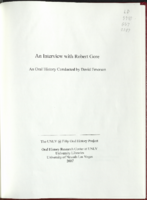
Transcript of interview with Robert Gore by David Emerson, January 31, 2008
Date
2008-01-31
Archival Collection
Description
Robert Gore first came to Las Vegas in 1973 as a public affairs officer with the Air Force. He returned to West Virginia to go into the family business in 1976 and four years later was offered a job with Summa Corporation. Back in Las Vegas, he also served as director of the Air Force Association. At a dinner meeting of the Association, Retired General Bill Becker suggested that an engineering school was needed at UNLV. Bob and the Air Force Association put together a group called FORGE, whose primary purpose was to promote a school of engineering. Bob Gore, Dave Broxterman, John Heilman and others began researching the idea of building an engineering school. They drew the interest of people at the Test Site, Nellis Air Force Base, and PEPCON, and put together a slide show and a binder full of research data. Bob and Dave presented their information to the Nevada Development Authority and Nevada legislators, and started a grassroots campaign to enlist the support of the people of Nevada. Bob gives details on the efforts that FORGE and many other individuals made on behalf of the engineering school. He takes readers into the myriad meetings that were held and the important associations that were forged with people like Tom Beam Lawrence Livermore Laboratories, the DOE, Jim Cashman, Mary Hausch of the Las Vegas Review Journal, Channel 3, Bob Thomas, and numerous others. The interviewer, Dr. David Emerson, was involved in this effort as well, and shares anecdotes concerning donations from a mining company and Reynolds Electrical and Engineering Company. Today Bob is working with a real estate company in Las Vegas. Twenty-some years later, he still recalls the hard work and dedication of people like Benet Stout, on loan from Senator Chic Hecht's staff, the legislators who unanimously cosponsored the bill initiating the building project, and the original FORGE group who gave their all to the idea of a school of engineering at UNLV.
Text
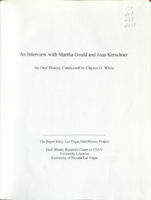
Transcript of interview with Martha Goulda and Joan Kerschner by Claytee D. White, October 26, 2005
Date
2005-10-26
Archival Collection
Description
Martha Gould and Joan Kerschner have been instrumental in most phases of library development in Nevada - from the branch to the state library. Their stories are fascinating and cover the techniques of moving a physical library to installing massive computer systems. They became librarians as young women and worked their entire careers in the field. Their memories add depth and profound meaning to the work of librarians. Gould grew up in a small mill town on the Sugar River and attended the University of Michigan. A librarian at Dartmouth College gave her a job and then insisted that she return to school for a master's degree. She earned her MS in Library Science from Simmons College. Kerschner hails from the Midwest, growing up in Abe Lincoln country. As a young girl, she went into their little Carnegie Library to rest and to view photographs on the stereograph while in town shopping with her family. She attended college across the river at Kentucky Wesleyan College and then earned a master's in library science at Indiana University. Martha and Joan have lobbied and testified before assembly committees to help bring libraries in Nevada to their current standing. This interview is about serious work told by two women, one who became state librarian, who look back over their many accomplishments with laughter and great joy.
Text
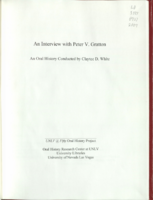
Transcript of interview with Peter Gratton by Clayee D. White, February 26, 2009
Date
2009-02-26
Archival Collection
Description
Peter Gratton was born in 1944 in Staten Island, New York, where his father was in the Coast Guard. However, he spent his childhood in Minnesota. From 1965 to 1969, Peter was a member of the US Marine Corps, serving a tour in Vietnam. As his military duty was ending, he learned that his parents were relocating to Vegas, bringing with them all of Peter's belongings. So Peter caught up with them in Vegas where he transitioned to civilian life in a new city by "bumming around for a couple of months." He decided to stay and took a keno job at Golden Gate Casino. In 1981, he graduated from UNLV and was accredit to teach history and earth science. This proved to be a good background for an opening at the UNLV library and he helped organize the map collection. With that, his UNLV library career was successfully launched. At the time of this interview, Peter was Administrative Assistant III Lied Library Building Department. In the following pages Peter tells of his experiences that lead up to becoming a Las Vegas resident and longtime member of the UNLV library staff.
Text
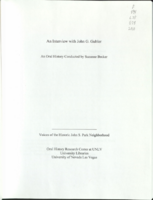
Transcript of interview with John G. Gubler by Suzanne Becker, December 29, 2008
Date
2008-12-29
Archival Collection
Description
When John Gubler's parents moved to Las Vegas in 1936, it was a simple desert community of only six or seven thousand people. John's father practiced law and his mother raised the four Gubler sons. Home was in the John S. Park area. It was a fenceless neighborhood where everyone knew each other. Parents worked hard at their various jobs and kids played on the barren stretches of desert shooting BB guns, exploring artesian wells and playing games. As the gaming industry and the city grew, the Gubler household focused on education and family. It was a life of freedom and no TV. They were a family raised in Mormon values. John went on to become a lawyer and move back to raise his own family here. Today he lives on the western side of the valley. He explains that as an adult when he drives through John S. Park Neighborhood, "I live in the past." It was a good life. As John reminiscences about growing up from the 1940s thru 1960s, his observations are vivid and range from local
Text
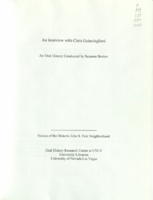
Transcript of interview with Chris Guinchigliani by Suzanne Becker, July 20, 2007
Date
2007-07-20
Archival Collection
Description
Three decades prior to this interview, Chris Guinchigliani moved to Las Vegas and began teaching at the Clark County School District. Seeing Las Vegas as a place of personal opportunity, she involved herself first in the teachers union; eventually serving as president of the Nevada State Education Association from 1987 through 1991. She shares some of her political experiences being elected to the Nevada State Assembly for 16 years and then became a Clark County Commissioner. Chris and her husband Gary Gray (above left) are longtime residents of the John S. Park Neighborhood and Chris was among those who originated the idea to getting a historical designation for the community. She highlights the process and obstacles within the community as people developed an understanding about what preservation really meant. She touches upon a broad range of topics that living in the neighborhood: Manhattanization, increased traffic, crime, lack of amenities such as a grocery store, the
Text

Transcript of interview with Sarah Haggerty and Lancy Kirk by Claytee D. White, February 2, 2010
Date
2010-02-02
Archival Collection
Description
Sarah Haggerty and Lance Kirk are a married couple with two small children. Both are born and raised Nevadans—he's from Reno and she's from Las Vegas. Sarah has deeply rooted memories of the John S. Park area, her paternal grandparents' home is there. As a couple, Sarah and Lance reflect on home ownership in both the Huntridge and John S. Park areas. Lance, an architect, talks about the house and the social communities. And ultimately asks the poignant question: Is the community making us or are we making the community? Sarah reminisces about the transition in the neighborhood, a transition that she feels began in the 1990s as the original owners aged and their homes were sold to a new generation of owners at a time when the greatest growth in the valley was to the suburbs. She may harbor nostalgic feelings, but she is also a realist: It's just different. We face different challenges but we have different rewards too, she says.. Among the most significant changes is the increased Hispanic demographic, which she guesses to be nearly 50%. They talk about the challenge of getting these residents more involved in the community's social and activist causes. About crime, they observe that is isn't necessarily higher, but it is affected by the homeless population that gravitates there. Their wish list includes: sidewalks, parks, community centers, more restaurants. However, none of this discourages their love of living in John S. Park. They have been actively involved in projects that draw the community together, from door knocking to using social networking to assist those efforts.
Text
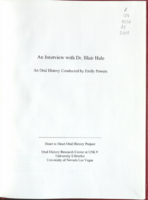
Transcript of interview with Blair Hale, by Emily Powers, June 16, 2006
Date
2008-06-16
Archival Collection
Description
Dr. Blair Hale has been practicing dentistry in Las Vegas for over thirty years. He was born in Idaho in 1949, the third of four children born to Zendal McKay and Lenny Raymond Hale. His education includes semesters at BYU, El Camino City College, and a dental degree from Washington University. Dr. Hale recounts his experiences as an undergraduate at Washington University in Missouri, living in a dorm situation and signing for government loans. He also examines his early days in Las Vegas and the ease with which he obtained bank loans to start his business back in 1976. At that time there were relatively few dentists practicing in Las Vegas, and when he was the dentist society president in 1985, he knew most dentists by name. Blair explains his work with the Academy of LDS Dentists, which sends groups of dentists to Guatemala, Peru, Honduras, and the Dominican Republic to run week-long free clinics. The clinics not only treat the dental problems of the populace, but also serve as instructional seminars for local practitioners. In addition to running a practice and doing charitable work outside the country, Dr. Hale also teaches at UNLV's dental clinic one day per week. He describes the changes in technology, technique, and materials over the years, and the quality education future dentists receive at UNLV. He also delineates the differences dental work can make in a patient's life, not just aesthetically but emotionally and physically as well. Dr. Hale comments on the dynamics behind the large influx of dentists in the 90s, the future of health care in Las Vegas, and the impact of third-party carriers in the dental profession. He believes that dentistry is a wonderful profession and that students can receive an excellent education at any good dental school in the United States. His sons are contemplating following him into this field.
Text
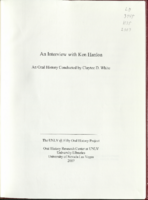
Transcript of interview with Ken Hanlon by Claytee D. White, November 29, 2006
Date
2006-11-29
Archival Collection
Description
Ken Hanlon was born in Baltimore, Maryland, in 1941. He attended 2nd grade through high school in Parkville schools. He took up his first instrument, the snare drum, at the age often, and by eighth grade had taken up baritone horn and trombone. His parents were very supportive of his interests. Ken developed a very strong work ethic early on, through the influence and example of his parents. He earned money in high school to pay for things he wanted by assisting on a paper route. He also took private lessons, which he paid for, and played in a dance band. After graduation, he attended Peabody Conservatory on a scholarship. He finished his last two years there with the principal of the Baltimore Symphony. He taught at Peabody Preparatory for seven years as undergraduate and graduate. He continued his Master's degree at Peabody Conservatory while working as a public school instrumental music teacher. He also played in the rock and roll band and worked in a city concert band. In 1968, Ken and his family moved to Las Vegas. He connected with the Si Zentner band and went on the road with him, then played in hotels up and down the Strip. Ken worked in bands that backed many famous headliners and has many anecdotes and memorable stories to share about those days. In 1970, Ken interviewed with Howard Chase, chair of the music department at UNLV. He was hired and his first UNLV job at the age of 29 was chair of the music department. He kept this position for 16 years, with one year off to establish residency for his doctorate. Dr. Hanlon has had a long and varied career, filled with people, places and events vital to the music industry. Today he continues to teach a graduate course, is currently Las Vegas president of the International Trombone Association, and runs the Arnold Shaw Popular Music Research Center.
Text
Pagination
Refine my results
Content Type
Creator or Contributor
Subject
Archival Collection
Digital Project
Resource Type
Year
Material Type
Place
Language
Records Classification
